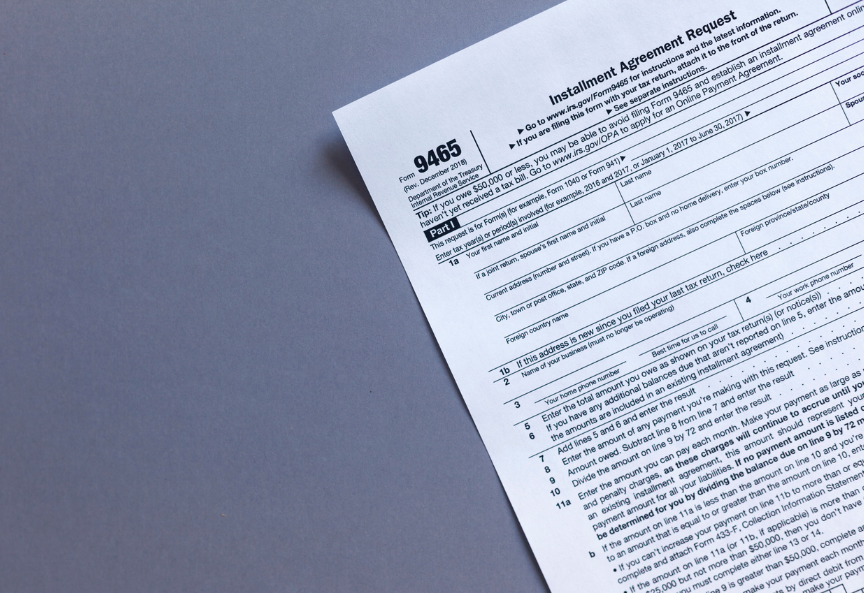No one likes being in debt – and being in debt to the government is a particularly precarious situation. Nevertheless, whether through extenuating circumstances or simple math mistakes, it is estimated that collectively, American taxpayers owe over $110 billion in back taxes, spread among millions of taxpayers. This is where Form 9465: Installment Agreement Request can come in handy.
The IRS typically does not stand idly by while it is owed money and will make it clear that you owe a debt through written notices. The IRS will first notify you about their recent tax assessment declaring your debt, and then again when it aims to begin implementing collection actions against your account. These collection actions start with a federal tax lien on all your property.
This lien hinders you from seeking financing or liquidating assets without addressing your tax debt by superseding all other creditors – culminating in a physical claim of your help and property through a tax levy. There are ways to stop the IRS from trying to force collection, even if you can’t pay your tax debt off in a single cheque. Your best bet is a payment plan, usually an installment agreement.
What Is Form 9465: Installment Agreement Request?
An installment agreement is an agreement made with the IRS that allows you to pay off your debt in a series of monthly payments over more than 180 days, rather than a single lump sum or several lump sum payments within six months. Installment agreements differ in length depending on the severity and size of your debt. In addition, your financial status and the age of your debt can play a factor too. Tax debt is only collectible for about ten years from the tax assessment date, plus tolling periods. This period means the IRS will be more eager to collect on your debt the closer you get to the ten-year mark – and more lenient about the amount you can pay.
Short-Term Payment Plan vs. Installment Agreement
IRS tax debt can be paid off in three ways – immediately, through several structured payments within six months, or in monthly installments over the next few years. The first two are self-explanatory; however, it is the installment agreements where things can get complicated. Depending on how you intend to make your payments, the IRS may have different requirements for you.
For example, you can automatically stream your debt payments if you want to wire the money each year through an automated agreement and your debt is below a specific limit. This limit is a streamlined installment agreement, only available to taxpayers with an obligation below $50,000. If you’d make those payments yourself, or if your debt is too high, however, you may need to file a Form 433-F, collection information statement, and your agreement form to give the IRS a solid overview of the details of your financial health.
If you owe less than $10,000, you may be able to qualify for a guaranteed installment agreement. This payment plan allows you to rule out the possibility of a federal tax lien, as long as you do not default on your payments. Furthermore, if your tax debt is $50,000 or less, you can simplify the application process and file for an installment agreement online, which requires a much lower setup fee.
For debts above $50,000, however, Form 9465 becomes mandatory. This debt type is an Installment Agreement Request that you must print out and mail back to the IRS alongside all your relevant information. Form 9465 determines what you’ll be paying each month. You can reduce what is owed each month by including an initial payment alongside Form 9465, which will be subtracted from your total debt.
Filing Form 9465: Installment Agreement Request
The first three sections of Form 9465 are specific personal details, including your name, address, and contact information. From section 5 onwards, the form lets you calculate your monthly payments by taking your initial amount owed, subtracting the price you intend to make alongside the document (if any), and dividing it by 72 months. Then, you can volunteer your maximum monthly payment based on your current financial confidence. If you can pay more than your total debt divided by 72 months, your installment agreement will run for less than six years.
If you cannot match the suggested monthly installment payment amount, you must fill out a Collection Information Statement. This statement determines whether you are eligible for a partial payment plan or an offer in compromise. If you can match or exceed the suggested monthly payments and your debt is below $50,000, you may opt to make payments via direct debit by providing your bank account details. You can also opt to make payments via payroll deduction. If you do not wish to make automated payments, you must fill out a Collection Information Statement.
What If You Can’t Pay at All?
If you cannot pay off your debt within 72 months, the IRS will work with you to determine a reasonable payment goal. Depending on your financial situation, you may be able to opt for a partial payment plan, an offer in compromise, or elect to be currently not collectible until your finances improve. Only choose the latter if you cannot spare anything in the months to come, and every cent you make needs to go towards keeping yourself or your family off the streets. While the IRS will no longer force collection actions while you are not collectible, your debt will continue to grow. Making payments as soon as possible is your best bet toward becoming debt-free.
Where to Get Form 9465: Installment Agreement Request
If you aren’t sure how to proceed, it may be in your best interest to speak with a tax professional personally. Navigating the rules and requirements of the IRS can be a pain, and before you make a mistake, it’s better to have someone navigate you through the filing process of Form 9465: Installment Agreement Request. It’s crucial to consider seeing a tax professional if you are in a financial situation wherein an offer of compromise might make the most sense.
While they are designed to offer leeway to taxpayers going through a tough time, offers in compromise remain a relatively unpopular choice within the IRS unless their hand is forced. The IRS does not want to agree to take less money. However, a convincing offer may be your best shot to finally put your debt behind you – without forcing the IRS to resort to any other collection actions. At Rush Tax Resolution, we can help you figure out the best way to approach your payment plan with the IRS and minimize your time in debt.

